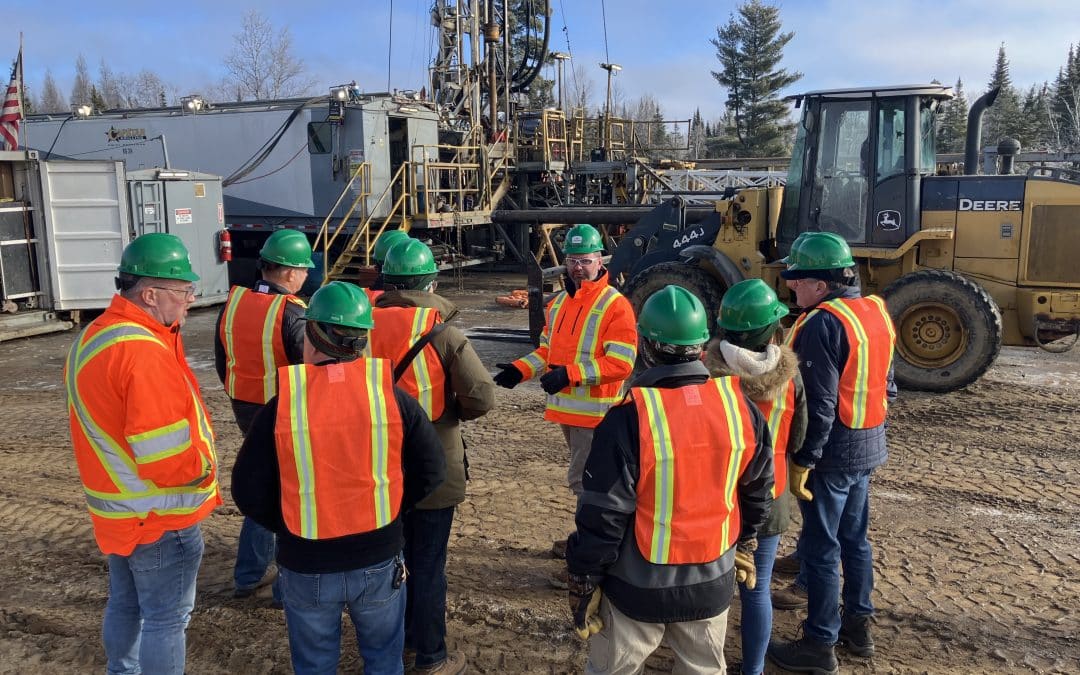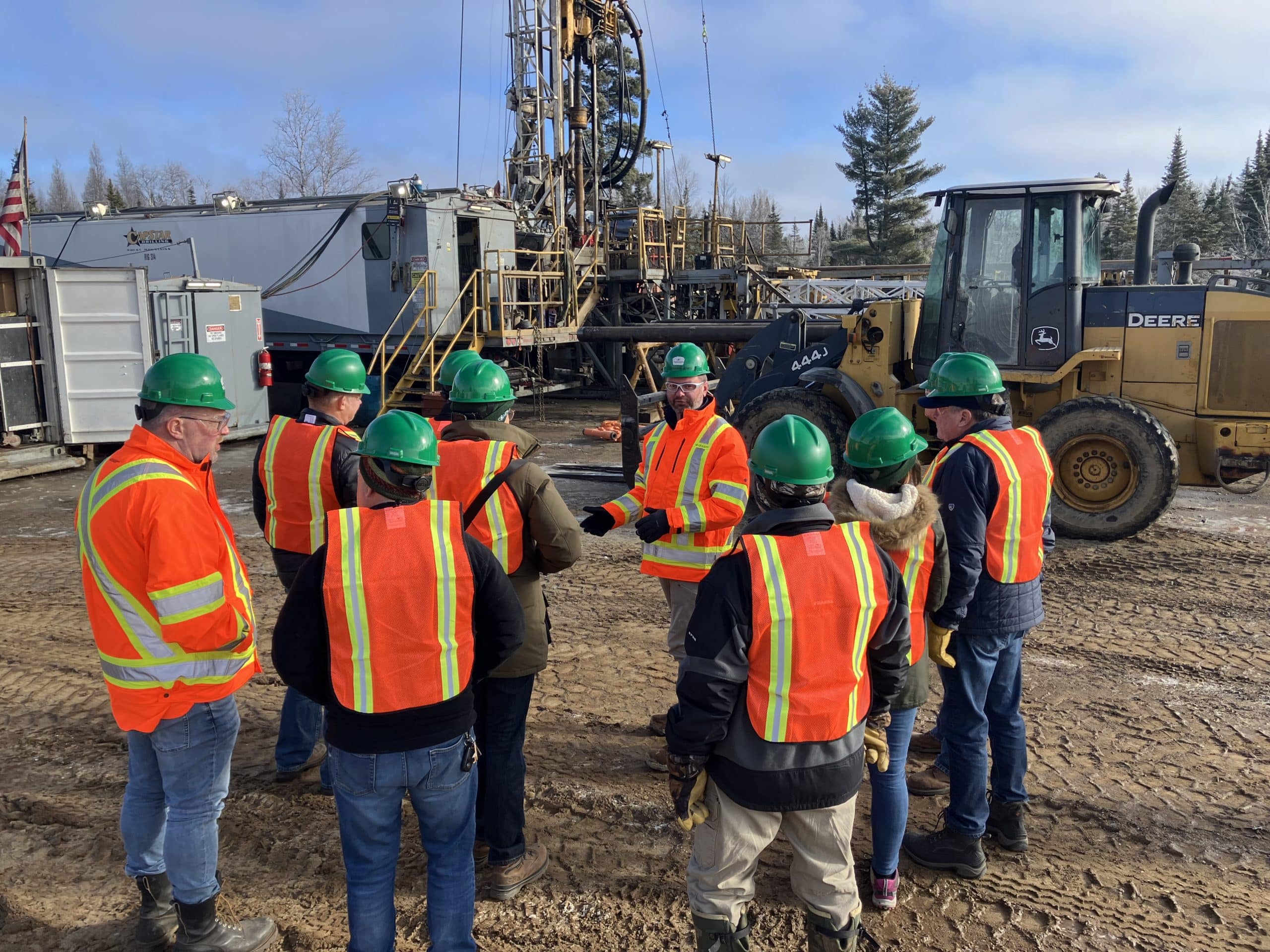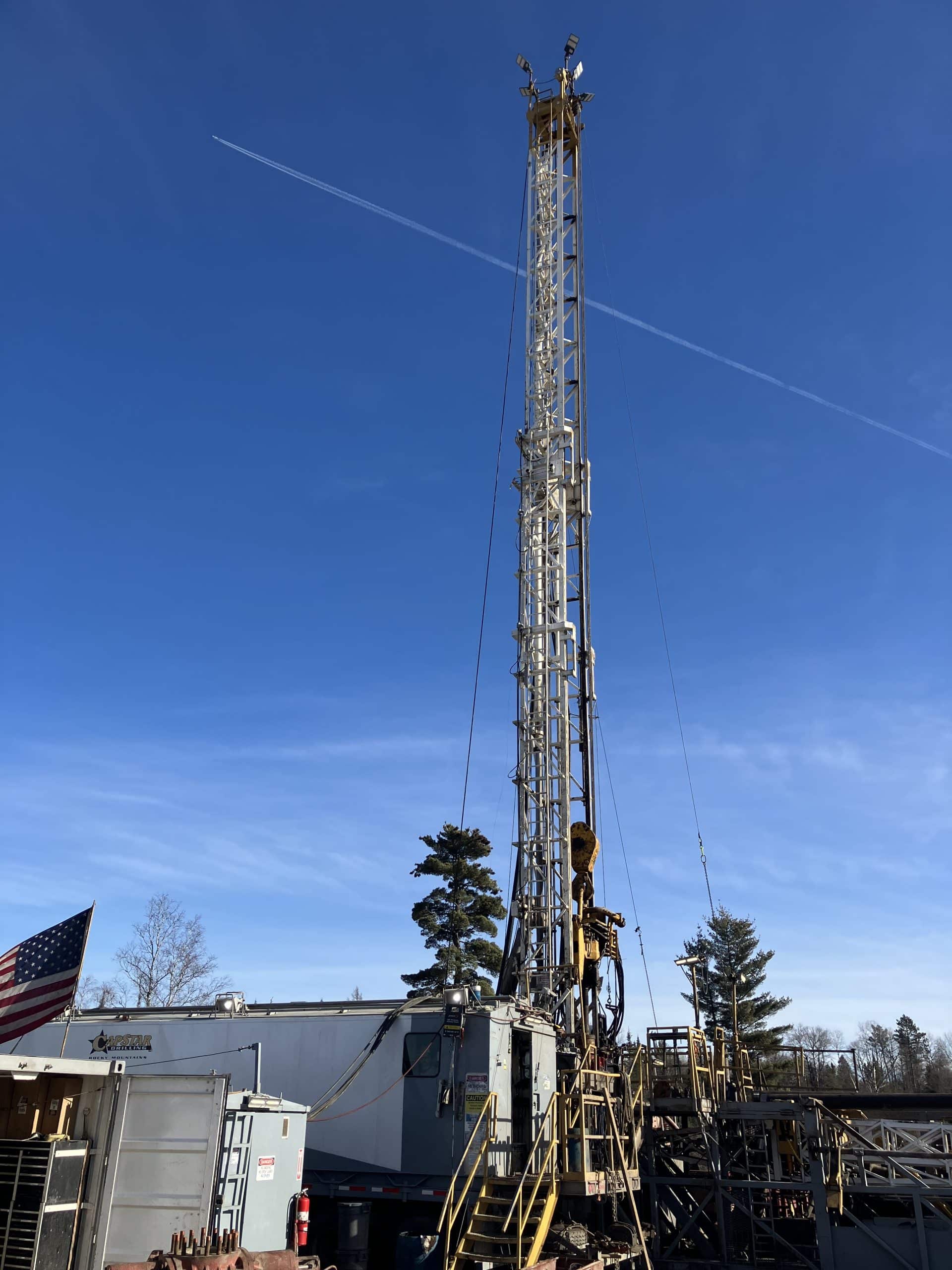In late February, a team working for Pulsar Helium tapped into a concentration of helium in Lake County near the edge of the Boundary Waters Canoe Area Wilderness.
Helium was first discovered accidentally near the BWCA in 2011 by a team of researchers looking for precious metals such as copper and nickel.
The site where the helium was found is near Highway 1 and Lake County Highway 2, not far from the small community of Isabella and the center of the 2021 Greenwood Fire that led, in part, to the closure of the BWCA in 2021. Pulsar is calling the site “The Topaz Project.” The company reports that “Topaz has been drilled with helium contents identified of up to 13.8%, making it one of the highest-grade discoveries in history.”
Thomas Abraham-James is the president and CEO of Pulsar Helium. He spoke with Joe from Paddle and Portage about the discovery of helium near the Boundary Waters and how his company plans to extract it from the earth.
This interview has been edited for context and length. Listen to the full interview in the audio and video shared at the bottom of the page.
Joe Friedrichs: What can you tell us about the significance of this discovery of helium near the Boundary Waters?
Tom Abraham-James: Well, we certainly believe that it’s significant. It’s a brand-new occurrence and new discovery. Helium has been in short supply for the past 10 years. So to find a potential new jurisdiction, something which is extremely high content, just like with any sort of resource industry, the higher the concentration the better it is. And we’re the first mover there. We’ve got to a point, I guess you could call it the end of phase one, where we’ve definitely identified that there’s helium gas down there. And now it’s really looking out to see, okay, well, how much is there? And could it support production? For Minnesota, this is something that’s brand new. I see it as a great opportunity for the state and local community. The supply in North America has been in decline for almost a decade now. It went from being the world’s number one helium producer and losing that crown. But this discovery is also good for the world. There are not many places you can look for helium that don’t have hydrocarbons attached. And that’s what we specialize in.
JF: What can you tell us about Pulsar Helium? I bring that up, Tom, because there has been concern from some of the other interested parties to extract near the Boundary Waters, particularly mining conglomerates from around the world with questionable track records when it comes to the environment. What can you tell us about Pulsar and where that might or might not be an accurate comparison?
TAJ: Well, you’re looking at one of the major shareholders, and I’m certainly not a big multinational company. Maybe an international, being English. But apart from that, there’s not much else. But I personally have a background in helium exploration, I’ve been doing it for 10 years. And that’s how I got drawn to Minnesota. We listed on the Toronto Stock Exchange in Canada last year, and we do not have a parent company. There is no one else above us. It’s the shareholders, co-founders, and some of the sort of seed investors, individuals, much like myself. We chose to list a company in Canada because the options typically for early-stage exploration companies were like, we don’t generate revenue. So, you could think of us as a bit of like a research and development company.
JF: You’ve described the quality of the helium here near the Boundary Waters as being “mind boggling.” What can you tell us about the helium that’s been discovered here?
TAJ: In our latest findings, we were getting helium readings up to 13.8%. So put that in context, anything that is 0.3% helium or more is deemed to be potentially of economic significance, something that you could possibly produce helium from. So, to have 13.8 is a big deal. It is the highest concentration in North America.
JF: In terms of the state, the county, essentially the government side of this, you’re entering into some uncharted territory from Minnesota. That’s being navigated right now, certainly at the state level at the Capitol in St. Paul. Our state senator is working on some legislation to work on how royalties might be paid, and the county is kind of in limbo on that is issuing conditional use permits. And there’s this process is kind of tied up while they figure out how they might get theirs. Where do you land on that process? Tell us your take on the government side of this?
TAJ: We lead by geology, not where these the certain mineral rights are. So that’s the first thing. The helium guides us. We’ve been working on this behind the scenes since about 2019. And that’s a lot of that’s been on the licensing side of things. It’s a brand new commodity that no one’s ever heard of before in Minnesota. So that’s quite reasonable. We started up the world’s first helium company only 10 years ago. So I’m not surprised by that education being required. But I must admit that the welcome we’ve had has been fantastic. So you mentioned the county, they’ve been very welcoming, the state as well. We’ve had ongoing dialogue with them, they’ve been great. We’ve had had permits from the Forest Service in order to get access, when it comes to actually doing a on field operation. So drilling, we’re regulated by the Minnesota Department of Health. So look, I can say that for us, like, we hold ourselves by very high standard. And we’ve regulations are there to be adhered to. And but when it comes to say things like revenue and taxes, that’s life. So, all I can say is that, considering that we haven’t been there for very long and now for this legislation that you talked about, from the company’s point of view, we’re just grateful for it.
JF: What can you tell us about how you extract the helium? Is it only directly underneath where the drill is, or if you can tap out, you know, into other areas to the north, south, east, west and so forth, and then pull it up through that same drill site?
TAJ: It is drilling, which would be sort of akin to oil and gas drilling to look at, but there’s some subtle sort of differences. We only do what’s called conventional drilling. So you hear this term fracking thrown out there quite a lot. That’s something that we do not do. Nor do we do directional drilling. What we do is, it’s a vertical hole into the ground into a gas reservoir. If there’s a water table present, we make sure that we do not interact with that water table. It’s a bit like a telescopic drill hole, so you drill down a certain diameter. And then so we went down to 90 feet. And then that then is cemented in that, that sort of steel casing there. So if there is an aquifer that’s present, then it is sealed off, then you go down to a narrow diameter, and then you drill down. So you know if there’s any gas or anything or mud or whatever it may be, it’s not going to go up and interact with that water table. The next thing is with sometimes with drilling, you have to use different additives. There are no chemicals. It’s organic material. So it could be things like clay, it could be sawdust, or wood chips, that’s what we use.
The only consumable for processing plant for helium is electricity. You don’t use water. There are no big pipelines. Also, helium is nonflammable. It’s nontoxic, all these things. And the footprint itself would be quite small because of the volumes, so you’d be looking at something which would be the size of a medium-sized warehouse, something like that, potentially.
JF: Is there a concern the government will try to tax you in a way that doesn’t seem fair? Are there others who might also be coming to extract helium here?
TAJ: I think the first thing is that there is no concern with the county or the state. There’s never been any concerns. I mean, that that kind of legislation is standard practice for gaseous mobile substances. So it wouldn’t come as any surprise put it that way.
It is likely there will be other players coming in. We’re the first company to do it. But others are likely to come, and I think that’s healthy. It brings greater confidence. If there are more companies out there doing things, then there’s power in numbers. So, I welcome it. I think that it’s not an isolated occurrence. So yeah, I think it’s only a matter of time.
JF: Do you have any idea how much helium there is to take out from under the Boundary Waters area?
TAJ: No, this is our job. This is what we need to determine.
JF: Prior to the helium discovery, had you ever heard of the Boundary Waters?
TAJ: Yes. I probably first heard about it when I was a teenager. So, I’m a geologist, and the Duluth Complex, where the nickel and copper guys are and where our project is, that’s pretty much in every single geological textbook out there. It’s famous. It’s quite a privilege to be working up there. I live in Portugal, but I just got back from visiting from Minnesota and the drill site again. That was just a couple of days ago.
JF: Had you heard of the BWCA and canoeing and the outdoors here from a place of recreation, as opposed to just geology and extraction and so forth?
TAJ: Yes. I know it’s awesome. I’m a geologist, so my life is spent outdoors. So for me, it’s a wonderful area. What we need to take into account is that it’s something that we will have to be responsible for, to protect. I think it’s incredibly important.
I didn’t grow up saying I’m going to become a helium specialist. It’s something that started because of the rare nature of this gas. And I happened to make, about 10 years ago, a discovery in a different country. What’s neat about it is that inert nature of it, that it’s we’re not dealing with something toxic or hazardous. Its footprint is very small. There are no big holes in the ground like you would if you’re extracting rock. We’re extracting gas. So, you’re looking at a hole in the surface, which is just a couple of inches in diameter. And that’s it. So really, the footprint is minuscule.
And helium is useful in modern times. We couldn’t have the computer we’re talking on now without helium. It’s used for manufacturing semiconductors, fiber optic cables, MRI scanners. Hospitals are the single biggest consumer of helium. And probably the biggest waste of helium are party balloons. For something that’s sort of useful and rare, it’s a bit of a waste. And for all these reasons, hopefully, that passes on to your audience that we’ll be very respectful and continue to be respectful of the area that we work.
JF: Your company made the discovery of helium near the Boundary Waters in February. What happens next?
TAJ: Right now, the site has a wellhead on top of it. It looks like a fire hydrant. That’s all it looks like right now, a fire hydrant with a fence around it. We’re waiting for the roads to reopen (weight restrictions). When that occurs, we’ll be doing pressure and flow testing. This is where we find out the velocity of the gas. And then you do a pressure test to find out how quickly it will replenish. After that, we give all the data off to an independent third party who then does a calculation to say okay, ‘this is what we say this is how much gas is present with a certain sensitivity to it.’ Then we would start a feasibility study. And that will be then determining, okay, how would it look like in a production scenario? Would it be economically viable? Yes or no? And then looking at all aspects of a production? So, what would be the impact on the community? Is there any impact on the environment? You know, the logistics. Can it be done? The geology? How big is it? Things like that. So that’s, you know, by the end of this year, give or take, we may be in a position where we have a good understanding of the potential of the project.
JF: If it moves forward and there is one truck per day driving away from the site, can you put a monetary potential value on that one truck as it drives away?
TAJ: I’m looking at all comes down to the sort of the prices there it helium is pricing is a bit opaque. It’s not like gold, where you can just Google search, and there it is. So, you have to look at contract prices. But I mean, we’re aware of contracts are anywhere between $400 to $1,000 per 1000 cubic feet. So, it would mean any truck could be potentially worth $400,000 to $1 million worth of product.
You have to remember, we haven’t made the decision to go into production. We’re at the exploratory phase. We have time on our side.
JF: Thanks for your time and for having this conversation with us today.
TAJ: We’ll do it again. Thank you.
Click here to download the full conversation or listen to the audio online.
Watch the recorded conversation below:
Other Recent Articles
Forest Service Tells BWCA Campers They’ll Be Fined Or Face Jail Time Under New Food Storage Rule
Photo by Pete Nuij on UnsplashIf you bring a blue barrel to store food on a trip to the Boundary Waters Canoe Area Wilderness, you better hang it from a tree. Otherwise, it could cost you $5,000. And you might end up in jail. This according to an order issued April 19...
Young Cancer Survivor Talks About the Importance of Wilderness
Julia Ruelle (stern) paddles in the BWCA during her "parent-free trip" the wilderness. Submitted photoNote: Julia was the winner of Ely Outfitting Company’s first annual Boundary Waters Teen Essay Contest in 2018. She was 16 years old and a sophomore at Minnetonka...
Congress Talks Wolves and Mining As Quota Season Starts in the BWCA
Photo by Eva Blue on UnsplashNewsToo many wolves and not enough mining near the Boundary Waters Canoe Area Wilderness. These were two themes brought to the forefront of Congress this week at the urging of U.S. Rep. Pete Stauber, who represents all of northeastern...








